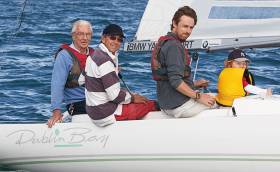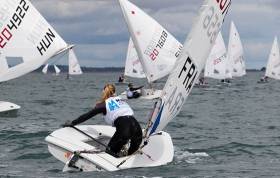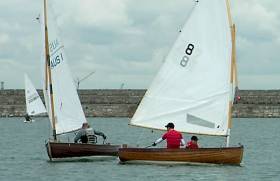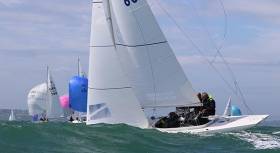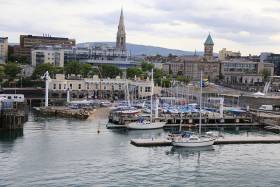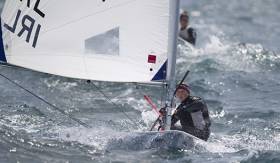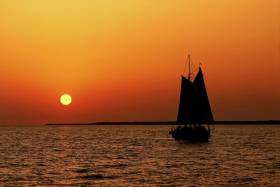Displaying items by tag: Royal St George Yacht Club
Four Generations of Dragon Sailors Afloat on Dublin Bay
Proving sailing really is 'a sport for life' are four generations of the Maguire family from Dun Laoghaire, afloat on Dublin Bay recently in a Dragon keelboat. The Royal St. George Yacht Club clan were out for a day sail aboard Garry Treacy’s Dragon 'Dublin Bay'. Pictured from left is Great–grandad Noel (92), Grandad Paul (66), grandson Rory (38) and great grandson Evan (2). All four are eldest sons.
Is it another record for the international class that races for national championship honours in Kinsale, West Cork this weekend?
Racing Abandoned, Royal St. George Will Try for Three Races on Final Day of Laser Radial Worlds
On tomorrow's final day, the KBC Laser Radial World Championship fleet will launch at 8am in an attempt to sail three more races. Dun Laoghaire's Royal St. George Yacht Club organisers are aiming for a first gun at 1000hrs, two hours ahead of schedule.
Racing on the penultimate day of the championship was abandoned today when the wind died, leaving the biggest regatta fleet in Ireland this year becalmed on Dublin Bay.
A number of races were started on both race courses but scrubbed when a fickle north–westerly breeze dropped from five knots to zero.
Since the regatta began on Monday, the boys fleet have sailed eight of a scheduled 12 races, the girls have sailed seven and the mens fleet nine.
The latest forecast is for westerly winds at 10mph at start time. No race may start after 1500hrs tomorrow.
Overall results are here
Wexford Boat Club's Ronan Wallace leads the KBC Mens Laser Radial World Championships at the halfway stage at Dun Laoghaire Harbour. In the boys division Howth Yacht Club's Ewan McMahon has produced a stand out performance after five races to be in third position in the biggest fleet of the competition.
In a consistent showing for the host nation entry, 27–year–old Wallace counts four top ten results on his scoresheet. He tops the international leaderboard but it couldn't be tighter as the Irish Moth sailor shares the same 36–points overall as second placed Nik Pletikos of Slovakia and Holland's Maarten Bastiaan Smit in the 42–boat fleet.
Early morning westerly breezes up to 19–knots on day three of the regatta allowed race officers to catch up on the race programme. There was praise across the dinghy park for the way the race management teams had persevered in the fickle winds since Monday.
'This is another great regatta in Dublin and I am enjoying sailing in these difficult conditions' said Croatia's Sven Stevanovic who counts a race win in his scoreline. Stevanovic is making a return trip to Dublin Bay having also competed at the Royal St. George Yacht Club when it staged the Optimist dinghy European Championships in 2014.
It was the same thumbs–up verdict from Brazil's Victor de Marchi who compared the venue to his home club, except there are 'no waves in Sao Paulo', he said.
Use of alternate marks, constant wind–moniotring and two nimble race management teams kept the championships on course again today despite the variable conditions.
It was another seven hour day on the water but it was a productive one that balanced the boys fleet races and by tea time each of the four boys fleets had sailed five qualifying races. Overall, the boys are led by American youth Henry Marshall who counts three race wins but Ireland's Ewan McMahon has four results in the top five and is discarding a seventh as the regatta enters its halfway stage for the boys divisions tomorrow. The host club's Conor O'Beirne took a race in race five yesterday afternnoon to put him in ninth place, the second Irish sailor in the top ten overall.
The girls fleet sailed three races today leaving them only two behind the full programme.
 Laser Radial Girls search for wind in Dun Laoghaire. Photo: Gareth Craig
Laser Radial Girls search for wind in Dun Laoghaire. Photo: Gareth Craig
Norway's 18–year–old Caroline Rosmo leads her 76–boat fleet with three race wins from four starts. The Oslo sailor explained her race strategy was all about staying on the high tack but she revealed a change of plan for race two when the wind swung into the east. 'For this race I decided it was the strong current [a two–knot flood tide] that was the dominant factor for me'. It is Rosmo's first time to lead at a world championships.
Top Irish girls are Dun Laoghaire's Nicole Hemeryck in 13th and Howth's Aoife Hopkins in 18th overall.
Racing continues tomorrow with a forecast for stronger winds. In a change to the sailing instructions, the race committee says it intends again to race three races back to back.
Results here are provisional and subject to protest.
Shifting winds, general recalls, black flag penalties and one abandoned race led to a drama–filled opening day at the 48–nation KBC Laser Radial Youth and Men’s World Championship on Dublin Bay, this afternoon.
Ireland, Croatia, USA and the Cayman Islands were four countries that made the most of the day's sub ten–knot breezes, each winning a race in their respective divisions of the 229–boat boys fleet.
But for all the on–the–water success of the day, there were also plenty of sailors seeking improvements tomorrow.
Sailors tackled offshore winds gusting up to 12–knots but sometimes the fickle summer breeze was as low as three knots.
Winds from anywhere between 225 and 300 degrees were strong enough to keep the dinghies moving through the small chop and tide but there was little opportunity for hiking. Upwind, the fastest sailors sought the strongest lines of pressure coming off the shore. Downwind, the on–the water umpires were active, with 28 rule 42 penalties for rocking and pumping infringements.
Back ashore, at the Royal St. George Yacht Club in Dun Laoghaire harbour, the youth sailors gave their first impressions of the Dublin race track.
'The winds are too shifty and the water is too cold! I'm going to have to learn how to sail all over again in this place', joked Israeli green fleet sailor Yam Lauber who counted a 21.
Course area B, under Rio appointed Olympic Race officer Con Murphy, completed its full programme but London 2012 Race Officer Jack Roy on course A was forced to abandon all three fleets half way through the second race when there was a major wind shift.
'This bay's a good place to sail but the shifts are random. I'd a good first race but let's not talk about the second', said Great Britain's Arthur Brown from Royal Burnham YC on the river Crouch.
But Spain's Rafael de la Hoz Tuells, who scored two second places in the boys blue fleet, appears – by today's result at least – to have mastered Dublin's notoriously difficult westerlies.
'I sailed today by concentrating on the clouds and following the wind', said the number two Spanish sailor from Murcia.
Check out some video footage of one of today's races.. @LaserWorlds2016 pic.twitter.com/GbXqZhfqlz
— Royal St. George YC (@RSGYC) July 25, 2016
In home nation news, Connacht champion Ewan McMahon from Howth Yacht Club was a race winner in the blue division and after the first qualifying race in the girl's fleet, his club–mate Aoife Hopkins was 13th from 76.
The first race of the girls fleet was won by Norway's Caroline Rosmo. There was no second race result available at the time of publication.
In the mens division, Ireland's Ronan Wallace had a race win, the other race of the day in the 42–boat fleet was won by Martin Manzoli Lowy of Brazil.
Racing continues with two more qualifying races tomorrow. Similar westerly winds are forecast.
Results HERE are provisional and subject to protest.
The historic International 12 foot Dinghy Class and Dublin Bay 12 footer Irish Championships will be hosted by the Royal St. George Yacht Club on August 30th.
Only one race is required to be completed to constitute a series and there will be one discard if four races.
Prizes will be the Seapoint Trophy and the Cora Cup which are the 12 Foot Irish National Championship prizes.
Laser Radial Worlds At Royal St. George Promo Video
The volunteer team at the Royal St. George Yacht Club has released a pre-event video for next week's 2016 Laser Radial Worlds at Dun Laoghaire. See the video below. An intense two weeks of Laser action kicked off on Dublin Bay last Saturday when the National Yacht Club staged the Laser Leinster Championships. The 52–boat radial division, was won by Royal Cork Yacht Club's Johnny Durcan, a boost for the Munster youth who will head up a large Irish contingent on July 23rd.
The Dragon Edinburgh Cup 2016 came to a spectacular conclusion off Abersoch as the 35 strong fleet enjoyed one finalrace in glorious sunshine, big waves and a brisk west-south-westerly of 18-22 knots. Going into the day the only way that second placed Grant Gordon, Kasper Harsberg and Ruihrihd Scott sailing GBR780 Louise could overtake leader Lawrie Smith sailing GBR801 Alfie with Joost Houweling and Adam Bowers was to finish first and hope that Smith finished seventh or worse. Meanwhile Mike Budd, Jeremy Entwistle and Mark Greeves in GBR793 Harry needed to win the race and have Gordon finish seventh or worse to enable them to move up into second.
Two Royal St. George boats were in the top five, Martin Byrne, a previous winner, finished fourth and Neil Hegarty was fifth.
Smith, Houweling and Bowers are three of the most skilled and experienced sailors you could hope to see in a Dragon and if you ever wanted a lesson in how to win a championship this was the day to be spectating. As soon as Race Officer Malcolm Blackburn had the fleet under starters orders is was clear that Smith had no intention of letting his rival out of his sights. "We knew what we had to do and that's what we focused on. Starting in the right place or going the right way up the first beat weren't important, just that we kept Grant under control." Explained Joost Houweling after racing. And keep him under control they did with masterful poise through the prestart and up the first beat. At the first mark Neil Hegarty sailing IRL176 Phantom with David Williams and Peter Bowring led Mike Budd off down the run, whilst Smith and Gordon were buried well down into the pack.
Smith kept Gordon right where he wanted him on the first run and having ensured he had neutralised the threat Smith let loose and began to make places up through the fleet, leaving Gordon trailing in his wake. It's a sheer joy to watch a great sailors put Dragons through their paces upwind and as the breeze built on the final leg the spectators got to enjoy some textbook big wave sailing. Smith continued to pick off boats all the way up the leg, while Budd, conscious that Gordon was well down the fleet, put all his energies into getting past Hegarty to win the race. On the line Hegarty just managed to hold off Budd for line honours, James Peters, David Cummings and James Dawson aboard GBR662 Yeah Baby took third and Smith snuck in for fourth, a gnat's whisker ahead of Mark Dicker, Selina Dicker and James Campbell in GBR610 Rackham and Gavia Wilkinson-Cox, Mark Hart and Tim Tavinor in GBR761 Jerboa.
With the final points calculated Lawrie Smith, Joost Houweling and Adam Bowers were declared the Edinburgh Cup 2016 Champions by an eight-point margin - the second time that Lawrie has won this historic trophy. The fight for second went to countback with Gordon and Budd counting 17 points apiece and Gordon just pipping Budd for the second step on the podium.
Whilst Mike Budd, Jeremy Entwistle and Mark Greeves were disappointed not to have taken second overall, they were none the less delighted to have won the Corinthian Dragon Edinburgh Cup Trophy by five points from Mark Dicker. Third place in the Corinthians came down to another tie breaker with Neil Hegarty and Rob Campbell both on 16 points, a single point behind Dicker, and Hegarty taking third on countback.
As well as second Corinthian, Mark Dicker, sister Selina Dicker and cousin James Campbell also won the Vintage Division Trophy for boats built at least 20 years ago. The Dragons have always had a reputation for outstanding build quality and this can be clearly seen in the number of older boats that have performed well this week. Second place in the Vintage Division went to GBR746 Beauty & The Beast, helmed by Peter Marchant with Katie Cole and Andy Biddle, while GBR655 Phormerly Phantom helmed by Chris Thomas and crewed by Selina Thomas and George Bird-Jones came third.
Despite the occasional lack of sunshine, the Dragons have enjoyed both outstanding racing and truly exceptional hospitality this week in Abersoch. Special thanks must go to Race Officer Malcolm Blackburn and his team who did an excellent job of completing all six championship races in what were often very tricky conditions. The Abersoch Dragon Fleet and the team at South Caernarvonshire Yacht Club have pulled out all the stops to make the fleet welcome and to organise an outstanding championship. At the Prize Giving Gala Dinner British Dragon Association Chairman Tim Wilkes paid tribute to the dozens of volunteers who have given up so much of their time to make this event possible and particularly thanked Abersoch Dragon Fleet Captain Rob Riddell for his work not only on this regatta, but in creating a 21 strong club fleet at Abersoch from scratch in less than 10 years. He also thanked the club's administrative and hospitality staff for keeping the fleet organised, fed and watered in incomparable style.
In his Edinburgh Cup acceptance speech Lawrie Smith, a man not normally known for his verbosity at prize givings, not only thanked the organisers, but confirmed that the support and assistance extended to the competitors at this event and the standard of race management he had seen during the week were some of the best he has ever seen and that he would be delighted to compete in any regatta organised by the club. He also thanked his crew and his fellow competitors, particularly Grant Gordon and the Louise team, for the outstanding racing.
Full results here
The 2017 Dragon Edinburgh Cup will be raced from Cowes and will run concurrently with Panerai British Classic Week from 8 to 15 July 2017.
Though it may have been officially known as the Royal St George Yacht Club for at least 175 years, unofficially it has been known for longer than anyone can remember simply as “The George” writes W M Nixon. And if you were headed for its annual one day sailfest at the peak of the season, you were off to “The George Regatta”.
Some things have changed, and one relatively new feature of the modern Dun Laoghaire sailing scene is the biennial four day Volvo Dun Laoghaire Regatta. For this mega-event, everyone pools resources and membership of the waterfront clubs becomes virtually interchangeable, developing it into Irelands biggest sailing event.
That’s fine - so long as it stays biennial. It had become clear that while the burden of each club running its own annual regatta was giving poorer returns for the effort involved, every other year a combined effort gave good results.
But that in turn sharpened the appetite in alternate years for each club to revert to its own almost-traditional stand-alone regatta. Already this year we’ve had the National YC on Saturday 18th June. And then there was the Teng Tools Royal Irish Yacht Club Regatta this past weekend.
This coming Saturday, on July 2nd 2nd, it’s the Royal St George Yacht Club’s turn, and they’ve opted to pare right back in the title of their event, an historic regatta which in 1904 witnessed radio pioneer and inventor Marconi’s first experiments in transmitting race results from out in Dublin Bay.
An innovator like Marconi would probably approve of abbreviating the title. The only thing he might find unlikely is that German cars are now ahead of the cars of his native Italy. Be that as it may, this Saturday sees the Frank Keane BMW George Regatta in Dublin Bay with at least 27 classes racing, there are Try Sailing facilities as well, and there’s a wide range of entertainment and hospitality planned throughout the famous old club house and forecourt. Simple and modern, yet traditional and stylish at the same time.
July's Laser Radial Worlds At Royal St. George YC Attracts 350 Competitors from 48 Nations
The Royal St. George Yacht Club has announced that 48 countries and 350 competitors are now confirmed to compete in the KBC Laser Radial Worlds (Youth and Men’s 2016 World Championships) to be held in Dun Laoghaire Harbour in a month's time (23rd to 30th July). Competing countries will include countries such as Canada, Hong Kong, Russia, Singapore, Uruguay, the USA and New Zealand. This is the first time Ireland will host this World Championship with 1,000 supporters and volunteers involved in helping to host the event.
David Kelly, Chairman, KBC Laser Radial Worlds said, “Dun Laoghaire will be transformed into a cosmopolitan village with competitors now coming from all over the world. Our home sailors will face fierce competition but we are hoping for some top Irish placings on home waters.”
The event which is being sponsored by KBC Bank will be hosted by The Royal St. George Yacht Club and Dún Laoghaire Harbour Company and supported by Dun Laoghaire Rathdown County Council and Fáilte Ireland.
Royal St. George Yacht Club Celebrates Longest Day with 'Summer Sailstice' on Dublin Bay
Tonight the Royal St. George Yacht Club hosts a 'Summer Sailstice' for members and friends. It's not a race but a ‘leisurely sail’ on the Bay to mark the longest day of the year.
A course will be agreed 'upon muster' at the club pontoon at 6pm and will be weather dependent. The cruise returns around sundown.


























